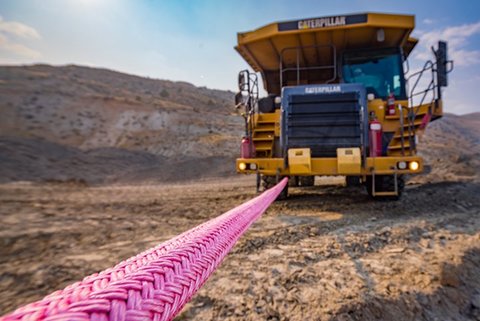Mine safety: Seven ways to make mines safer and more efficient
Mining safety specialists Carroll Technologies has signed a partnership with Samson to supply high-performance synthetic ropes to the North American mining industry. Synthetic rope offers numerous advantages over wire in terms of safety and efficiency.
Scroll down to read the article

Carroll Engineering President Allen Haywood. Credit: Carroll Technologies
H
igh-performance synthetic rope is being promoted as one of the latest ways that mine operators can improve efficiency and safety on their sites.
Carroll Technologies Group, looking to promote the benefits of high-performance synthetic rope to the US mining industry, recently became a distribution partner for Samson, the leading manufacturer of high-performance synthetic ropes.
Regional sales manager Donna Poll said: “Samson is excited about the partnership with Carroll Technologies Group. They are safety-based, and the products we make can significantly contribute to safer mining operations.”
Samson has been manufacturing rope for over 140 years and creates its rope from multiple fibres, including high-modulus polyethylene (HMPE), such as Dyneema® by DSM, which is among the strongest fibres in the world.
A key selling point for high-performance synthetic rope over wire (or metallic) alternatives is that synthetics are the same strength but only about one-seventh the weight for equivalent diameters. That makes synthetic rope safer to handle, and increases efficiency related to time to rig and personnel required.
Describing the safety improvement for miners, Poll said: “When wire rope breaks there’s a danger of damaging the surrounding area and people. Synthetic rope has much more predictable recoil properties.”
Synthetic rope safety advantages
Synthetic rope can be more expensive than steel, initially, but, as Poll puts it: “The cost advantages realised with increased efficiency and the safety factor cannot be discounted. You can’t put a price on safety.”
Working together, Carroll Technologies Group and Samson provide a complete solution for customers, as well as strong after-sales support.
Poll said: “We have a team of engineers who help support the sales effort. There’s a synergy with Carroll’s solutions-based approach.”
Samson is particularly pleased to be working with Carroll Technologies Group on continuing to expand the use of synthetic rope in the metal and non-metal side of the mining industry in the east and southern basin of the US, having already seen widespread adoption of the product in the coal industry.
Asked what the main benefits are of synthetic rope, Poll says: “It’s safer, lighter, faster and easier.”
The safety benefits are two-fold: first, because synthetic rope is so much lighter, there is less likelihood of sprain and strain injuries for those handling it. Second, recoil (what happens when a rope breaks) is more predictable.
Polls said: “When wire rope breaks, it snaps back in an uncontrolled manner and creates metal shrapnel that can damage or destroy anything that gets in its way. Due to its inherently torque neutral construction and low stretch, a high performance synthetic rope allows for a more controlled and predictable release of energy should it part.”
Using synthetic rope leads to overall savings because it is so much lighter than wire. “If you are recovering a piece of equipment that’s stuck and weighs 300,000 pounds, the wire rope required is going to require a few people and a small crane to get in place. Synthetic rope is much faster to get into place, so downtime is reduced. It’s also easier to use so it improves your efficiency.”
President of Carroll Technologies Group, Allen Haywood, said: “We are excited to be starting this partnership with Samson. It is a unique safety product that fits in well with our focus on safety and enhances our offering.”
Throughout Ukraine, the mining industry’s general debt is estimated to be $18.7m
During the first ten months of 2017, Ukraine spent $2.15bn on coal imports
Separatist complications
The wage arrears and other concerns have built up in the coal mining industry in Ukraine for a number of reasons. Allegations of corruption have been made by many, including Oleksandr Kharchenko, managing director at Energy Industry Research Center in Kiev. He claimed that the money from state-run mines has been redirected, which has been a key cause of the wage arrears.
Others claim that the deep nature of Ukrainian coal operations and low productivity of many mines has made them unprofitable; they have therefore been heavily dependent on government subsidies for years. The level of these subsidies has changed with each government, without great reform to the industry.
Communication failures between the MECI and state-run mining companies and unions have allowed the situation to reach the critical point it is at today.
“We urge the Ukrainian Government to re-launch social dialogue with the unions, and take effective measures to solve the problems affecting the coal industry,” said IndustriALL Global Union general secretary Valter Sanches in a letter to the Prime Minister of Ukraine. “We stand in solidarity with our affiliated trade unions and our fellow miners in the Ukraine and support their legitimate demands and necessary legal steps required to protect the rights of workers.”
Political and military upheaval has complicated the situation. In April 2014, pro-Russian separatists formed a militia that took Donetsk and Luhansk out of the Ukrainian Government’s control. In July 2017, they announced that they had founded a new country called Malorossiya, or Little Russia in English.
The four Selidivvugillya mines that have been striking this year lie very close to the eastern border with the People’s Republic of Donetsk, increasing the tension in the region. Many miners are concerned that due to unpaid wages they could not afford to move in an emergency, putting them and their families at risk.
Furthermore, 85 coal mines lie inside this disputed region. The resource-rich area accounted for 57% of production up until 2014, when reports stopped. Only 35 state-run mines are outside of this region, which must continue producing coal for domestic use. It is currently illegal to purchase coal from the separatist regions; however, there are reports that it is being sold to Russian, Polish and other European companies.
Since 2014, Ukraine has engaged in numerous coal import deals to make up for the lost supply created by the loss of territory. The majority of coal has been imported from Russia, which provided 55.7% - $1.2bn worth - between January and October 2017. The country has also begun importing American coal for the first time in its history, in particular anthracite, the price of which America has tripled since 2016. Overall, during the first ten months of 2017, Ukraine spent $2.15bn on coal imports.
With the significant challenges caused by the separatist movements drawing focus, many miners feel ignored by the government. As government officials in Kiev try to limit illegally sold coal and avoid an energy crisis, communication has broken down with the remaining coal miners.
With the significant challenges caused by the separatist movements drawing focus, many miners feel ignored by the government. As government officials in Kiev try to limit illegally sold coal and avoid an energy crisis, communication has broken down with the remaining coal miners.
Panther

A time for communication
Ukrainian state mines currently employ 51,000 workers, and are the main source of employment in regions such as the Donetsk coal basin. Mine closures over the last few years have already decimated towns and the government does not desire to close more but there is little clarity on how to progress in a profitable and sustainable way.
“The development of state-owned mines is possible in a stable environment, but wages must be paid on time,” said Trade Union of Coal Industry Workers of Ukraine deputy chair Valery Mamchenko. “Last year, UAH2.8bn ($100m) was allocated for the development of the coal industry, including the wage fund, but this year the amount is less than half.”
Without communication with unions and workers, many fear that Ukraine’s coal mining industry will remain stuck in its cycle of non-payment, protests and emergency measures. “It is essential to pay wage arrears in full; stamp out corruption in the industry; appoint managers of enterprises and mines on merit alone; and establish an effective social dialogue with trade unions,” said the Independent Trade Union of Miners of Ukraine president Mychailo Volynets.
The next few years will determine the future of Ukraine’s mining industry; now is the time for the government to focus on and support coal communities. Whether or not mining is to continue to play an important part in Ukraine’s economy and the lives of its citizens, or if it is time for the subsidies to be reduced and new energy industries to be grown, a plan must be made.
Ukrainian state mines currently employ 51,000 workers, and are the main source of employment in regions such as the Donetsk coal basin. Mine closures over the last few years have already decimated towns and the government does not desire to close more but there is little clarity on how to progress in a profitable and sustainable way.
“The development of state-owned mines is possible in a stable environment, but wages must be paid on time,” said Trade Union of Coal Industry Workers of Ukraine deputy chair Valery Mamchenko. “Last year, UAH2.8bn ($100m) was allocated for the development of the coal industry, including the wage fund, but this year the amount is less than half.”
Without communication with unions and workers, many fear that Ukraine’s coal mining industry will remain stuck in its cycle of non-payment, protests and emergency measures. “It is essential to pay wage arrears in full; stamp out corruption in the industry; appoint managers of enterprises and mines on merit alone; and establish an effective social dialogue with trade unions,” said the Independent Trade Union of Miners of Ukraine president Mychailo Volynets.
The next few years will determine the future of Ukraine’s mining industry; now is the time for the government to focus on and support coal communities. Whether or not mining is to continue to play an important part in Ukraine’s economy and the lives of its citizens, or if it is time for the subsidies to be reduced and new energy industries to be grown, a plan must be made.
It is essential to pay wage arrears in full [and] stamp out corruption in the industry
Contact information
Carroll Technologies Group
Office: +1 (606) 573-1000
www.carrollengineeringco.com
www.deltaelectricwv.com